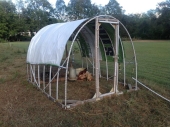posted 5 years ago
Kim is absolutely correct. Taking the time to predator proof need not be expensive, and is the responsible thing to do. You will save time, money and heartache, in the long run.
Foxes, raccoons, mink, rodents etc. can climb or dig under all sorts of fencing commonly used to house fowl (chicken wire is great at containing chickens, but pretty useless at repelling Predators). Predators cannot climb or dig thru metal roofing, concrete or appropriate sized mesh. Birds of prey will fly into unroofed pens, other predators will use nearby trees, buildings, vehicles or fencing to circumvent the most robust walls.
Floor must be wired (metal mesh, like hardware cloth) or concrete. Alternatively, you can trench mesh or metal roofing, at least 2 feet deep OR buried a few inches down, but coming OUT 2-3 feet, and INSIDE another 2-3 feet from enclosure wall; peg down or cover with gravel, rocks and/or dirt. This is how wolf, coyote or wild cat enclosures are done to keep them contained while in rehab or on display in zoo's, so it will certainly keep all manner of predators OUT.
Walls must be minimum 1cm (1/2 inch) hardware cloth OR use metal roofing at base (run lengthwise) and the small mesh above. Alternatively, electric mesh can be applied to the exterior of chainlink or other large mesh.
Roof must also be wired and/or metal roofing. If walls are electrified, old fish netting, or closely spaced (min 2 inches) fishing line will exclude Birds of Prey.
Recycled metal roofing can be a cost free alternative. Contact local roofing companies and ask if they are doing any replacement metal roofs; post on a local "Used" site seeking someone taking down a barn or such structure - often this saves dump fees so folks are grateful for someone to take it away.
Lorinne Anderson: Specializing in sick, injured, orphaned and problem wildlife for over 20 years.

 3
3





 7
7




 3
3




 2
2




 2
2




 3
3




 1
1







